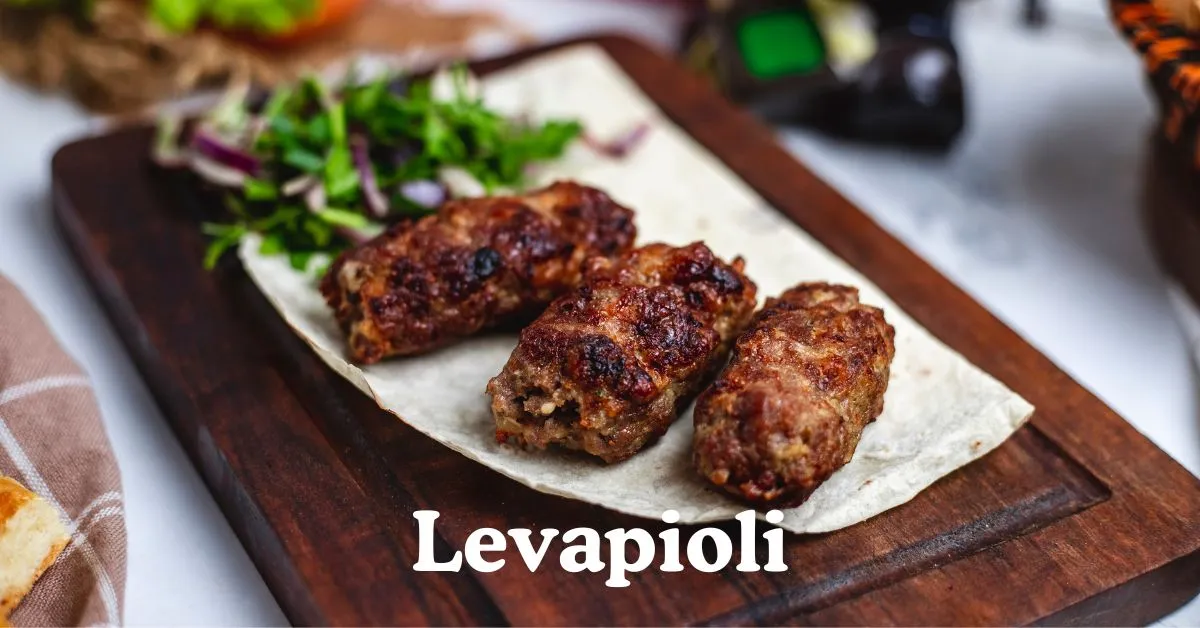Introduction
If you’ve never heard of levapioli, you’re not alone — but once you do, it’s hard to forget. This mouth-watering dish combines the rustic comfort of homemade food with the sophistication of regional culinary traditions. It’s the kind of meal that makes you stop mid-bite and say, “Wow, what is this?”
At its heart, levapioli represents more than just food — it’s culture on a plate. Its origins trace back to small European villages where locals crafted hearty meals using simple, natural ingredients. Over time, it evolved, traveled, and adapted to the tastes of different regions. Today, whether you’re tasting it in Italy, the Balkans, or beyond, each version tells a story of tradition, community, and flavor.
So grab your appetite, because we’re diving deep into the world of levapioli — exploring its roots, variations, recipes, and the reasons it’s becoming a favorite among global food enthusiasts.
History and Origins of Levapioli
The story of levapioli begins in the heart of Southern and Eastern Europe, where food was often a reflection of life itself — simple, resourceful, and shared. It’s believed that the word levapioli stems from older regional dialects that described ground or “pressed” meat dishes cooked over open flames.
Historically, it was a dish of the working class. Shepherds and laborers would grind available meats — often beef, lamb, or pork — and season them with local herbs. The mixture would then be grilled or pan-fried, producing something fragrant and filling.
Through centuries of cultural exchange and migration, the dish spread to various parts of Italy, the Balkans, and even parts of the Mediterranean. Each region gave it a local twist, shaping it into what we now know as levapioli — a comforting, flavorful emblem of traditional cuisine.
The best part? Levapioli never lost its humble origins. Even today, it’s served at family gatherings, festivals, and small-town restaurants — connecting generations through the universal language of food.
Popular Levapioli Variations in Italy
Italy, known for its regional culinary diversity, has embraced levapioli in many unique forms. Every province adds its own local ingredients, making it a symbol of creativity and tradition.
1. Apulian Levapioli
In Apulia, a southern Italian region known for robust flavors, levapioli takes on a bold identity. Locals often use horse meat or mixed beef-pork combinations, seasoned with garlic, black pepper, and herbs. The result? A smoky, slightly sweet flavor that pairs perfectly with warm piadina (flatbread).
2. Emilia-Romagna Style
Here, the dish becomes more refined. Finely minced pork is seasoned delicately with parsley, thyme, and rosemary, then grilled until golden. This version is often enjoyed with fresh bread and olive oil — a testament to the region’s mastery of simplicity and quality ingredients.
3. Sicilian Levapioli
As always, Sicily adds its creative flair. Locals incorporate olives, capers, and sometimes sun-dried tomatoes, giving the dish a punchy, Mediterranean flavor. Each bite tells a story of sunshine, sea breeze, and centuries of cultural blending.
Every Italian variation, while distinct, holds onto one core philosophy: fresh, local, and from the heart.
Unique Levapioli Twists from Around the World
Levapioli didn’t just stay within Italian borders — its spirit of grilled, seasoned meats inspired dishes across continents. Let’s take a look at a few global relatives:
1. The Balkan Čevapi
In the Balkans, particularly Bosnia and Serbia, levapioli’s cousin is known as čevapi — small, skinless sausages made from minced beef and lamb. Typically served with flatbread and onion, they carry the same smoky essence and communal charm.
2. Turkish Kebabs
Crossing into Turkey, we find kebabs that share the same DNA — minced or cubed meat marinated in yogurt and spices, then grilled over charcoal. They often come with roasted vegetables and tangy sauces, echoing the same comforting warmth.
3. Argentine Choripán
Traveling even farther, Argentina offers its own spin with choripán, featuring spicy chorizo served in crusty bread and drenched in chimichurri sauce. It’s street food perfection, reflecting how the essence of levapioli — grilled meat and bread — can transcend borders.
Each variation shows that food evolves, adapts, and travels, just like people do.
Regional Differences in Levapioli Preparation
One of the most fascinating aspects of levapioli is how its preparation changes depending on where you are.
Ingredients
- Northern regions: Focus on pork and mild herbs like rosemary and oregano.
- Southern regions: Prefer bolder meats like lamb or beef, seasoned with paprika or chili.
- Mediterranean coasts: Incorporate olives, garlic, and citrus for a tangy touch.
Cooking Methods
While most people grill levapioli, some areas prefer to bake or pan-sear it, especially during colder months when outdoor cooking isn’t practical. The bread choice also varies — some use soft pita, while others choose crusty loaves for contrast.
These subtle variations keep the dish alive, showing how tradition and innovation can coexist on a single plate.
How to Make Traditional Levapioli at Home
You don’t have to travel across Europe to enjoy levapioli — you can make it right in your kitchen! Here’s a simple yet authentic recipe to try:
Ingredients
- 500g ground beef (or a mix of beef and pork)
- 1 small onion, finely chopped
- 2 garlic cloves, minced
- 1 teaspoon paprika
- ½ teaspoon cayenne pepper (optional)
- Salt and black pepper to taste
- Fresh parsley, chopped
- Olive oil for grilling
Instructions
- Mix everything — In a large bowl, combine the meat, onion, garlic, herbs, and seasonings. Mix until well incorporated.
- Shape the patties — Form small oval or cylindrical shapes (about palm-sized).
- Grill or pan-sear — Heat your grill or pan on medium-high. Brush with olive oil and cook the patties for 3–4 minutes per side until browned and juicy.
- Serve — Enjoy them with fresh bread, salad, or a tangy yogurt sauce.
Pro Tip: Chill the mixture for 30 minutes before cooking. This helps the flavors develop and keeps the patties firm while grilling.
Cooking levapioli at home is more than a recipe — it’s an experience that connects you to old-world comfort and authentic culinary joy.
Tips for Finding the Best Levapioli Restaurants
If you’d rather taste before you cook, here are some tips to find authentic levapioli when dining out:
- Seek Authenticity – Look for restaurants that specialize in regional or traditional cuisine. If they hand-make their patties or bake bread in-house, that’s a good sign.
- Check Reviews – Online reviews often mention whether the flavors and textures are true to the original style.
- Ask Locals – Locals always know where to find the real deal.
- Observe the Ambiance – The best levapioli spots usually have a cozy, welcoming atmosphere with the smell of fresh herbs in the air.
- Fresh Ingredients Matter – Great levapioli depends on high-quality meat and authentic spices.
A little research goes a long way when you’re chasing the perfect bite.
Conclusion :
Levapioli is proof that food doesn’t need to be complicated to be extraordinary. It represents the timeless bond between people, place, and flavor — a dish that has evolved through centuries yet still feels comforting and familiar.
Whether you try it at a family-run Italian restaurant, discover a Balkan-inspired twist, or make it in your own kitchen, one thing’s for sure — levapioli will win you over with its simplicity and soul.
So next time you’re craving something hearty, authentic, and full of history, give levapioli a try. You might just find your new favorite comfort food.
FAQs
1. What is levapioli made of?
Levapioli is typically made from ground meat (usually beef, pork, or lamb), combined with spices, herbs, and onions. It’s then grilled or pan-seared and often served with bread or flatbread.
2. Is levapioli the same as cevapi or kebab?
They’re related but not identical. Levapioli has its own regional roots and flavor profile, but it shares similarities with cevapi (Balkan) and kebabs (Turkish).
3. Can I make levapioli vegetarian?
Absolutely! Try using lentils, mushrooms, or plant-based mince instead of meat. Season generously with herbs and spices for authentic flavor.
4. What sauce goes best with levapioli?
Yogurt-based sauces, garlic aioli, or spicy tomato chutneys pair perfectly with the dish.
5. Is levapioli healthy?
When made with lean meats and grilled instead of fried, levapioli can be a protein-rich, nutritious meal. Pair it with salad or whole-grain bread for a balanced option.

